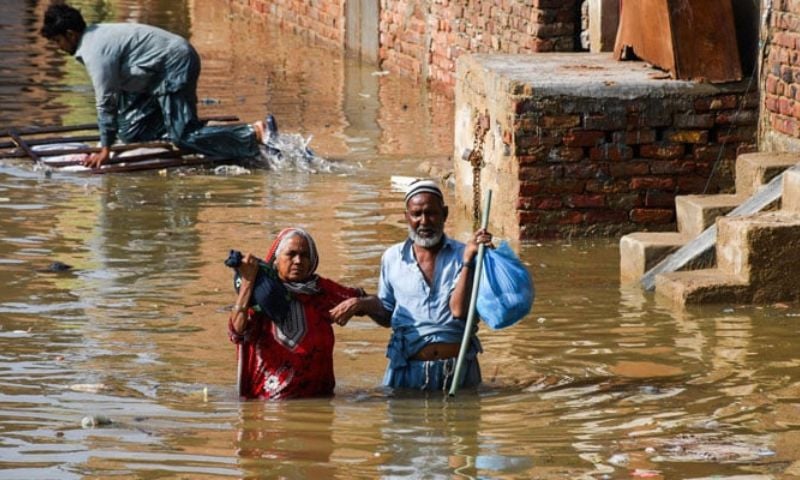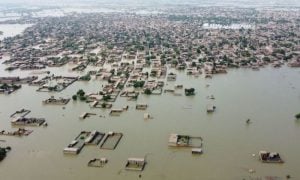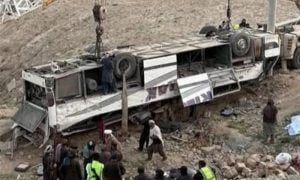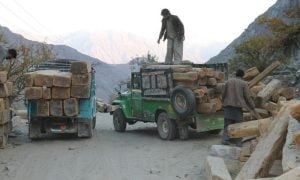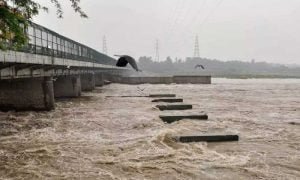ISLAMABAD: Pakistan’s Prime Minister Shehbaz Sharif on Wednesday ordered urgent national-level coordination to tackle the escalating flood crisis as the South Asian country braces for rising water levels in the Ravi, Sutlej, and Chenab rivers after India releases water.
Eastern districts of Punjab province are facing an “exceptionally high” risk of flooding due to a combination of heavy rains and the excess water India is releasing from the dams, authorities said.
India opened all gates of major dams on rivers in its part of the Indian Illegally Occupied Jammu and Kashmir (IIOJK) region following heavy monsoon rains, and warned Pakistan of the possibility of downstream flooding, local media reported, citing an Indian government source said.
Pakistan said Islamabad received the warning, and subsequently issued an alert for flooding on three rivers which flow into the country from India.
Chairing a high-level meeting, PM Sharif stressed that timely warnings and effective relief operations would be critical to protecting lives, infrastructure, and livelihoods.
The Prime Minister appreciated the advance warnings issued by the National Disaster Management Authority (NDMA), saying timely alerts helped avert major loss of life and property. He directed that the early-warning system should continue with more effectiveness.
PM Sharif noted that NDMA has already supplied tents to Punjab’s flood-hit areas and asserted that the early provision of other essential relief items must be ensured.
The Prime Minister instructed the authorities to take immediate administrative steps to prepare for possible urban flooding in Gujrat, Sialkot, Lahore, and other flood-prone districts of the province.
Premier Sharif further directed officials to ensure an uninterrupted power supply, restore communication networks, and repair damaged roads without delay.
He ordered the Minister for Communications, Minister for Power, Secretary Power, and Chairman National Highway Authority to reach Lahore and provide practical support to Punjab government.
Highlighting the federal government’s earlier assistance to Khyber Pakhtunkhwa during recent floods, PM Sharif assured that the same cooperation will be extended to Punjab and Sindh.
The Prime Minister stressed the importance of timely evacuation, safe relocation, and close supervision of relief operations, urging elected representatives and institutions to remain actively engaged at the district and tehsil levels.
Briefing the meeting, NDMA officials warned of high-level flooding risks at Head Marala and Khanki due to surging water in the River Chenab.
Heavy water discharge was also reported at Jassar and Shahdara in the River Ravi, and Ganda Singh Wala and Sulemanki in the River Sutlej. To facilitate evacuation, NDMA has deployed 2,000 trucks on standby.
The Prime Minister directed that preventive measures be implemented under a comprehensive strategy to protect lives, property, crops, and livestock from flood damage.
Rivers flow in high flood after India releases water
Meanwhile, the National Emergencies Operation Centre (NEOC) warned that the Ravi River at Jassar is carrying a high flood of 202,200 cusecs, which could rise to 229,700 cusecs.
At Shahdara in Lahore, the river is currently flowing at 72,900 cusecs, putting low-lying areas, including Shahdara, Park View, and Motorway-2 at risk of flooding.
The peak flow is expected to reach Shahdara between 10pm and 12am before moving towards Balloki around 9am on Thursday.
According to the Indus Water Commissioner’s office flood alert, a high flood is expected in the Sutlej River at Ferozepur (downstream), in the Ravi River at Madhopur (downstream), and in the Chenab River at Akhnoor.
Separately, the NEOC reported an extremely high flood in the Sutlej River, with 245,000 cusecs recorded at Ganda Singh Wala and 100,355 cusecs at Sulemanki.
In the Chenab River, an unusually high discharge of 769,481 cusecs was measured at Marala, with 705,225 cusecs recorded at Khanki. Officials noted that flows at Khanki have begun to ease.
Authorities said abrupt rises in the Ravi and Chenab rivers over the past 24 hours had posed serious challenges, prompting precautionary evacuations from vulnerable areas. Thousands of people have been shifted from floodplains in Punjab.
In Shakargarh, Narowal and Gujranwala districts, rescue teams have evacuated dozens of people trapped in floodwaters after heavy overnight rains swelled rivers and streams.
Roads, schools and villages were inundated in parts of Narowal, while sections of Head Khanki road in Gujranwala were submerged, cutting off access to nearby villages.
In Dadu, Sindh, floodwaters from the Indus inundated villages and damaged crops.
Meanwhile, the Flood Forecasting Division reported that Tarbela Dam had filled to capacity, while Mangla is nearing the three-fourths mark.
Low to medium floods were recorded at several barrages along the Indus, including Guddu and Sukkur, though the Jhelum, Kabul and other rivers were flowing normally.
The authorities decided to open the spillways at Tarbela Dam earlier this afternoon.
Rescue and relief activities
In line with Prime Minister Shehbaz Sharif’s directives, the disaster management authority is overseeing all rescue and relief operations.
NEOC said its control room is fully functional round the clock, while NDMA remains in close contact with civil and military agencies.
Residents living along riverbanks and waterways have been urged to immediately move to safer locations as rescue and relief teams remain on standby.
PDMA Director General Irfan Ali Kathia, earlier in the day, said that the water levels in major rivers across Punjab were expected to start receding following a pause in rainfall in the upper catchment areas. He said that the easing trend comes after days of heavy flows, particularly in the Sutlej, Ravi and Chenab rivers.
While addressing a press conference in Lahore, Kathia noted that the Sutlej had been in a “high flood” situation for five to 10 days but the flow at Ganda Singh was now steady at 245,000 cusecs and no longer rising.
In the wake of the situation, floodplains along the Sutlej, Ravi and Chenab rivers have been evacuated. Between 20,000 and 25,000 people were moved to safety from the Ravi and Chenab floodplains last night, Kathiya confirmed.
The PDMA chief said one of the primary challenges is the River Ravi, where the flow at Jassar had risen to more than 200,000 cusecs, causing the predicted surge at Shahdara tonight, before moving towards Balloki around 9am on Wednesday.
“The Ravi has a capacity of 250,000 cusecs at Shahdara. We expect the flow to remain between 180,000 and 190,000 cusecs, which can easily pass through,” he said. The last surge of this scale was recorded in 1988, when the river swelled to 346,500 cusecs.
Kathia said the sudden increase in water levels in the Ravi and Chenab yesterday had posed a serious challenge but evacuation efforts had been completed. “We are confident the water will safely pass through Shahdara and there will be no casualties,” he added.
Flood devastation
At least two people lost their lives in the past 24 hours due to rain and flooding, the NDMA said on Wednesday.
In Punjab, two individuals were killed in flash floods, the NDMA spokesperson quoted the new deaths.
After the recent casualties, the overall death toll from the monsoon rains has now risen to 804, while 1,088 people have been injured, the authority confirmed.
Of those killed so far, 482 were men, 119 women, and 203 children, the NDMA reported.
The spokesperson further said that 7,465 houses have collapsed due to the rains, while 5,584 livestock have perished.
Meanwhile, the surge in Ravi entered Kartarpur, submerging the entire area, inundating homes, fields, and even the revered Gurdwara Darbar Sahib. More than 100 staff members of the Kartarpur Project Management Unit were stranded, according to the local rescue in charge.
District Emergency Officer confirmed that rescue operations are under way to evacuate the project staff.
Pakistan Army rescue operations
The Punjab provincial government called in Pakistan Army troops earlier in the day to help rescue people from already flooded areas in the province, and for relief and evacuation efforts.
The rescue and relief operation is underway as floodwaters have inundated several areas, including Kasur and Ganda Singh Wala, following the overflow of the Sutlej River.
Army troops are using boats to move flood-affected people to safer locations. During the operation, residents’ belongings and livestock were also shifted to secure areas.
The Pakistan Army and district administration have established relief camps for those displaced by the floods.
With Rescue 1122, civil defence, police, and local administration already on the ground, the scale of the crisis has stretched their resources thin. The authorities had begun forced evacuations due to floods on Friday.
The Punjab Home Department had formally written to the federal interior ministry requesting the deployment of troops in the six districts.
The number of displaced people in Punjab due to flooding now exceeds 167,000, including nearly 40,000 people who left voluntarily following flood warnings since August 14.
The death toll from flooding in Pakistan since the start of the monsoon season in late June now stands at 802, half of them in this month alone.









